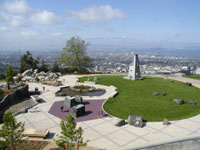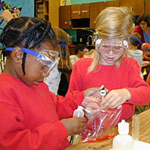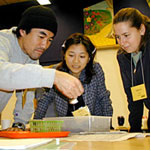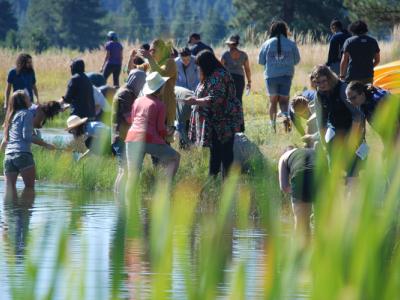Lawrence Hall of Science
The Lawrence Hall of Science (LHS), was founded in 1968 by the Regents of the University of California as a memorial to physicist E. O. Lawrence, the inventor of the cyclotron and the University's first Nobel laureate. Located above the campus, the Hall enjoys a spectacular site overlooking the Berkeley campus and the San Francisco Bay Area. A new outdoor, interactive exhibit, "Forces that Shape the Bay," will enable visitors to appreciate not only the beauty of the Bay, but also the geologic, climatic, marine, and human forces that have shaped it.

The Hall develops and disseminates model programs for teaching and learning science and mathematics and serves as a resource center for children, parents, educators, and policymakers seeking to improve the understanding and increase the enjoyment of science and mathematics. LHS is internationally recognized for its innovative mathematics and science programs that span curriculum development, public programs, exhibits, teacher education, and collaborative efforts with schools to better prepare students for higher education. It is unique among science centers in the convergence of these diverse activities and its integral association with the University of California. The Hall was a pioneer in the guided discovery approach to teaching science and this underpins the work of four program divisions: public science center, student and family programs, teacher leadership, and curriculum research and development.
Public Science Center
The Hall has created hundreds of original exhibits for its 56,000 square feet of public exhibition and program space which features a 27-seat interactive planetarium, biology discovery lab, computer lab, and other workshop areas. The Hall offers a platform to faculty scientists to reach a broad audience for cutting-edge research; for example, an exhibit explaining nanotechnology is currently under development. Thematic public programs are offered regularly with admission, from stargazing to bubble festivals to family days with hands-on activities and entertainment. A corps of 70 adult docents, about 90 teen interns, and numerous UC Berkeley students facilitate visitor experiences and conduct on-floor demonstrations for the quarter million visitors each year.
Student and Family Program

For more than three decades, the Hall has provided direct service to students and families, both at the science center and at school sites across the greater Bay Area. Classes, workshops, assembly programs such as Science Discovery Theater, festivals such as "Build It," and whole school immersion programs in marine science are among the 2,100 school programs that serve 275,000 students per year. FAMILY MATH is a school-based activity that has taken place in hundreds of schools in nearly every state; the leaders guide has been translated into Chinese, Spanish, and Swedish.
Teacher and Leadership Programs
Thousands of educators gain professional development through intensive summer institutes, one-day and multi-day in-service workshops. The Center for School Change helps schools at all levels to achieve systemic reform with sustained and coordinated support on issues from alignment with standards to parental involvement and technology in education. The Alliance for Collaborative Change in School Systems (ACCESS) works to increase the capacity of neighboring urban school districts to prepare historically underrepresented students for admission to four-year colleges. The Bay Area Mathematics Project and the Bay Area Science Project work to deepen teachers' content knowledge, give them strategies for working effectively with English Language Learners, and help them develop leadership skills so that they can work with their colleagues to increase student achievement. Family Health's goal is to enhance science, health, and math understanding of parents and educators of under-served students.
Curriculum, Research, and Development Division

From the post-Sputnik efforts of the sixties to incorporating current web-based technologies, the Hall has been a national and international leader in instructional materials development. A hallmark of this process is the intense collaboration with teachers as co-developers, field-testers, and providers of professional support to colleagues as they incorporate new approaches. Curriculum development builds on an extensive and growing national and international network of teacher centers in school districts, science centers, county offices, and universities. As a result, about 20% of American schools use LHS-developed materials. Major curriculum efforts include:
• FOSS (Full Option Science System)-the most successful and widely adopted hands-on curriculum in use-features kit-based modules supplemented with Web and CD-ROM activities. It is in use or being adopted in more than half of the largest school districts in the U.S.
• GEMS (Great Explorations in Math and Science) translates workshops, labs, and exhibits at LHS into preK-8 classroom activities that are trial tested and then published as teacher guides and handbooks. There are 80 current titles in print and more than 1.5 million books in print. Sixty sites and centers across U.S. support teachers in using the guides.
• Hands-On Universe (HOU) provides high school students with tools used by professional astronomers. Students download CRD images to their classroom computers and use HOU's powerful image-processing software to visualize and analyze their own data.
• SEPUP (Science Education for Public Understanding Program) is an issues-oriented curriculum for elementary and secondary schools and the community. SEPUP promotes the use of scientific principles and evidence in public decision making around issues such as environmental protection and public health.
• ScienceVIEW, an in-house multimedia development unit, ensures the innovative use of technology in learning materials the Hall develops.
Relationships with Campus
The Hall provides a place for science faculty to work in K-12 education and serves as an important part of the campus's outreach effort to extend opportunities at the pre-collegiate level to students from all economic backgrounds. It provides a gateway through which thousands of students each year have their first contact with the University. Many LHS programs reach out to under-served schools and students who encompass the great diversity of California. Undergraduate and graduate students have opportunities, including staff positions at the Hall and the "Communicating Science" course, to get a taste of teaching. Graduate student researchers and faculty have the opportunity to study science teaching and learning in informal and formal settings.
